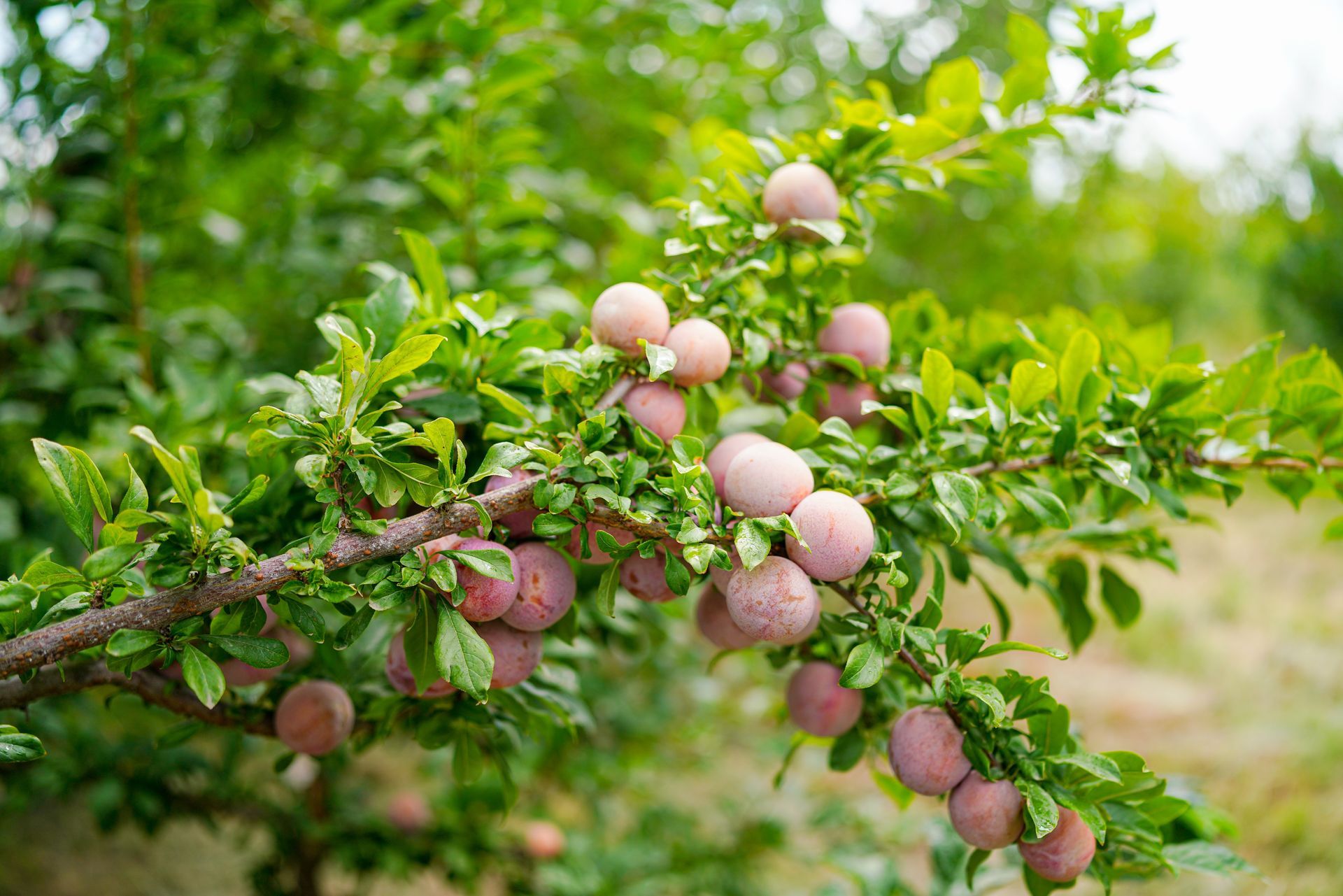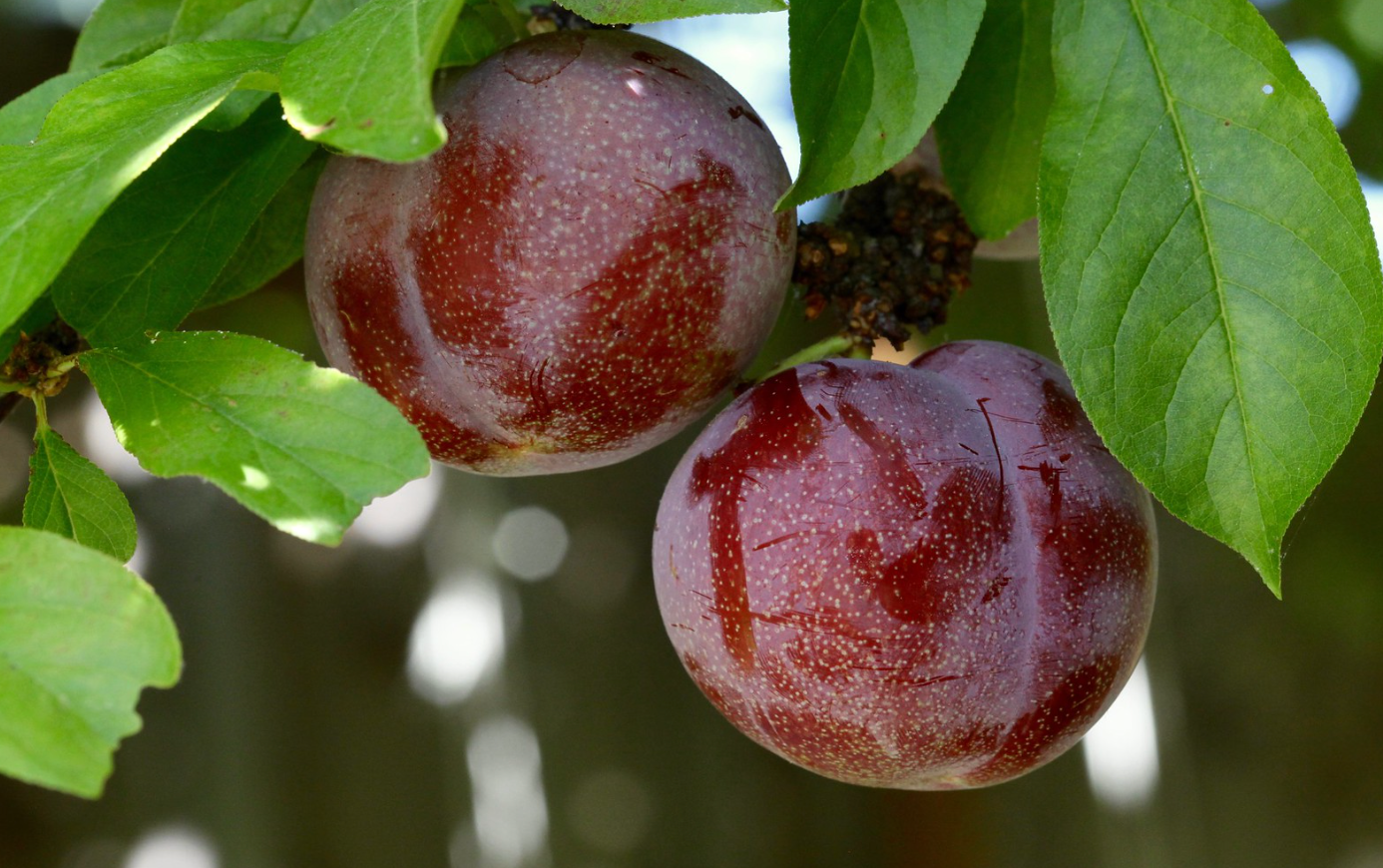Pluot Tree: Everything You Need To Know

The pluot tree is a semi-dwarf hybrid with beautiful white blooms and green foliage. Its fruit is sweet with a slight tartness to it, somewhat like an apricot. The tree can produce up to 50 pounds of this sweet fruit every season. Here's a detailed guide on growing your own pluot trees.
Fast Facts for the Pluots Trees
| Common Name | Pluot, Apriplum tree, Plumcot tree |
|---|---|
| Scientific Name | Prunus brigantina |
| Harvest | June to September |
| Light | Require full sun for a good harvest; ensure the planting site gets six hours of direct sunlight daily |
| Water | The root system should be soaked entirely every two to four weeks to keep the soil saturated along the root line; give one inch of water per week for best fruit production and growth |
| Soil | Require lightweight, well-draining, loamy soil with a pH level of 6 to 8. Plant in soil rich in organic matter for best fruit yield |
| Fertilizer | Need a 10-10-10 fertilizer to supplement the soil |
| Pests | Susceptible to attacks by tortrix moths, coding moths, spider mites, aphids, and scale insects |
| Diseases | Can fall prey to Silver Leaf Disease, Plum Pox Virus, Black Knot, Plum Pocket, and Brown Rot |
| Growing Zone | 6 to 10 |
Table of Contents
Everything You Need to Know to Take Care of The Pluot Tree
Pluot trees, also known as plumcot trees, are a hybrid of two trees; plum and apricot. Their fruit is plum-like in color but is different from plums in nutritional value. Floyd Zaiger, a Californian fruit breeder, has trademarked 'Pluot,' a tree with 30% characteristics of an apricot and 70% of a plum. There are about 25 pluot varieties.
Planting
Since pluot trees do not grow well from seeds, get bare root trees from your local nursery. The best time to plant a pluot tree is during dormancy, which is in early spring or late winter.
When planting a pluot tree, ensure the soil line is even with the soil around the tree. Press on the soil's surface to remove air pockets. After you plant the tree, water the area deeply. That will help the soil settle down. If the soil depresses significantly, add more soil to fill up the gap on top.
Prune the tree to a height of 30 inches at the time of planting. Cut the side branches back to four buds. Also, cover the soil with much, taking care to leave space between the trunk and the mulch.
Care and Maintenance
The main difference between a pluots tree and a plumcot is that the former is a trademarked name. Breeders that create 50-50 hybrids of plums and apricots call their varieties plumcots. Regardless of the variety you've used, the care requirements are similar for both types of hybrids.
Sun and Temperature
Since these trees grow best in USDA Zones 6 to 10, they are well-suited for mild climates. Plant your pluot tree in an area where it is exposed to about six hours of full sun daily.
Water and Humidity
You must water your pluot tree twice a week if planted in light soil. Water once every week if you've planted the tree in clay soil. Make sure the entire root zone is soaked deeply once a month. The soil needs to be saturated down to the bottom for proper tree growth.
Soil
Pluot trees need well-drained and loamy soil with slight acidity or alkalinity. The soil within the pH range of 6 to 8 is best for these plants. It should also be rich in organic matter to foster proper tree growth and fruit production.
Although pluot trees need moist, fertile, and well-drained soil, they can also thrive in other soils if they have enough nutrients and water. If your soil lacks nutrients, add amendments like compost or aged manure.
Fertilizing
Fertilize the pluot tree with a 10-10-10 or 8-8-8 fertilizer in early spring or late winter. Spread about 200 grams of the fertilizer over the root zone, or follow the instructions on the fertilizer packaging for dosage. Young trees require less fertilization.
As your tree matures, you need to fertilize it with higher quantities. Increase the amount to 1.5 pounds when the tree is fully mature. An annual spray of zinc foliar spray will also help protect the tree from pests and diseases.

Pruning
Pruning a pluot tree will keep it in good shape and protect it from diseases. Start pruning the tree when it is still young. Initially, limit the number of branches on the tree to five or six. These branches should be spaced at least 15 cm or 6 inches apart on the central stem.
Prune weak and broken branches from the pluot tree throughout the year. Also, pull the suckers growing near the trunk. As for major pruning, do it in spring before the opening of flower buds.
Propagation
The best way to propagate pluot trees is to graft in late winter. You can create your own self-fruitful hybrids with up to four different varieties on the same tree. Choose stone fruits like apricots for grafting. However, these species should be able to cross-pollinate with each other.
Harvesting and Storing
To check if the fruit is ready for harvest, grasp it and push it up. The fruit should have dark skin and a firm texture. You can also harvest it before time and let it ripen indoors. Eaten fresh, the fruit has a sweet flavor.
Harvesting
The simple way to harvest the fruit is to shake a pluot branch. Keep a sheet or tarp on the ground to catch the fruit. Or you can pick the fruit with a pole picker. It will start to produce fruit from June to September.
Storing
How long you can store pluot fruits depends on the variety. Some can be stored for two weeks, like the Flavor Grenade and Dapple Dandy. Others retain their sweet taste for about three days at room temperature and a week in a refrigerator. Cut the fruit into small pieces for long-term storage and keep them in freezer bags for eight months to a year.
Did you know? The Pluots trees are a cross between plum trees and the apricot tree. They are excellent little fruit trees that produce fruit which are a flavor king.
Common Issues With Pluot Trees
Pluot is a great tree to have in your garden, but it's susceptible to some issues.
Growing Problems
In the rainy season, the tree's roots can get water-logged. The soil should have good drainage to prevent this.
Underwatering can also damage the plant, resulting in premature leaf drop and yellow leaves. You must not grow pluots too close to each other since crowding restricts growth.
Pests
Japanese beetles are small green pests that result in leaf defoliation. Remove them by applying a soapy water solution to the affected plant or handpick the pests off the tree.
Aphids and spider mites also infest pluots since they feed on the tree's sap. A strong stream of water can often help you get rid of these pests. You can also introduce lacewings or other predatory mites to remove pest populations.
Diseases
Here are some common diseases of the pluots tree:
- Plum Pocket: It's a fungal disease that causes blisters and fruit swelling. Manage it with a Bordeaux mixture, which contains copper, lime, and water.
- Brown Rot: It causes sappy flowers and wilted fruit. Do not delay removing the affected fruit and disposing of it immediately. Apply a sulfur spray to the tree to stop the disease's progression.
- Bacterial Canker: Pseudomonas bacteria are responsible for causing this disease, resulting in the formation of sunken patches in the tree's branches. Since treatment is not an option, you should prevent this disease by following the right cultural practices.
Sweet New Earth's Final Word On Pluots Trees
Pluot trees are among the best fruit trees you can plant in your garden. They aren't extremely difficult to maintain and you can expect to harvest a delicious fruit each year.
FAQs

Christina Hernandez
Christina has done most of her research on environmental science but recently has changed her focus towards sustainable forestry. She has a passion for the outdoors and wants to spread that passion to the world.
Join our community!
Join to receive guides, insights, and the latest gardening deals!
